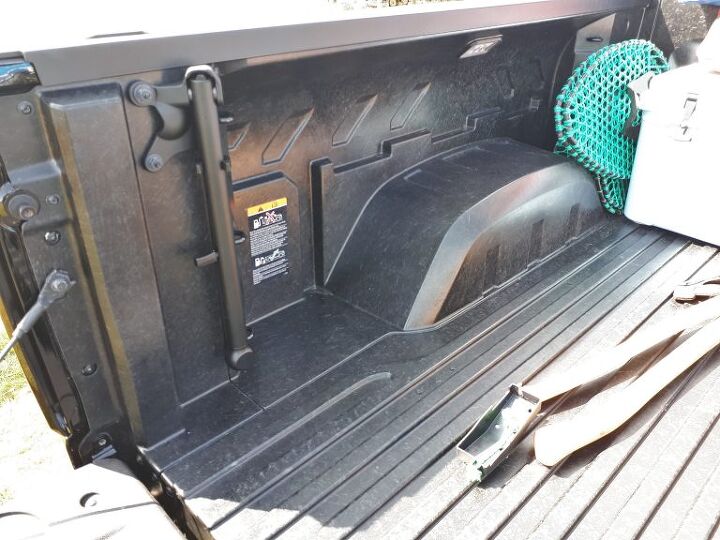Remember CarbonPro? GMC Hopes You Do - and Still Want to Pay Extra for It

In launching its next-generation Sierra half-ton last summer, GMC focused a lot of its attention on the brand-exclusive MultiPro tailgate, a bit of door-within-door wizardry that makes bed access a breeze. It also provides the necessary hookups for tailgate party tunes.
In short, to butcher a quote from Toronto mayor John Tory, the MultiPro has more positions that Masters and Johnson. But the bed behind the gate was also singled out for some attention. GMC told the public that a carbon fiber bed — CarbonPro, in GMC parlance — would join the 2019 model as a late availability option.
That’s still the plan. With production now two months off, GMC wants to rekindle some of that early interest in its seemingly indestructible bed.
Yes, buyers of the top-flight Sierra Denali and luxo off-roader AT4 will be able to tick the “CarbonPro Edition” box at dealers starting this summer, the brand announced this week.
Far from being a bedliner, CarbonPro is a full-on molded tub that’s open on one end, sheathed in exterior sheetmetal, and bolted to the frame. You can peer through the rear wheel wells and spot the material. It’s a great way to bump up the price — and exclusivity — of its Denali full-sizer.
GMC wants everyone to know just how much it toiled to get the bed right. The unpainted material was subjected to extreme heat, cold, a sustained generator exhaust blast, and airdrops of various objects, including cinder blocks, 1,800-pound loads of gravel, and 450-pound water-filled steel drums. The drops took place from “varying heights.” One imagines the engineers didn’t raise a crane to its full extension, though few non-military pickup owners demand that level of survivability.
We took a peek at a CarbonPro-equipped mode l in Newfoundland last August, where a GMC representative said the delay in getting the product to customers had something to do with finalizing a repair process for the nylon-based material. GMC would prefer it if you didn’t break the thing. We’d like to see someone try, as the corrugated bed can apparently withstand six times the payload that would deform a steel bed. The CarbonPro option shaves “about 60 pounds” from the Sierra’s curb weight and, because of its shape, allows an extra cubic foot of cargo volume in the bed. Payload increases by “at least” 59 pounds, depending on configuration and equipment, the automaker claims.
Small gains, for sure, but any and all progress is celebrated by OEMs (and at least somewhat respected by their customers).
Can CarbonPro change your life? Doubtful, though it might change your image, and that’s what GMC’s counting on as a motivator when these things come on the market. GMC, and especially GMC’s Denali sub-brand, is a license to print money. With CarbonPro, it hopes to print even more.
For the tail end of the 2019 model year, GMC plans to offer a limited number of Sierra Denali and AT4s outfitted with the trick bed, promising greater availability (on the same trims) in the coming model year. As for price, well, that’s still a mystery, but carbon fiber isn’t known for its budget appeal.
[Images: Steph Willems/TTAC, General Motors]

More by Steph Willems
Latest Car Reviews
Read moreLatest Product Reviews
Read moreRecent Comments
- Dave M. IMO this was the last of the solidly built MBs. Yes, they had the environmentally friendly disintegrating wiring harness, but besides that the mechanicals are pretty solid. I just bought my "forever" car (last new daily driver that'll ease me into retirement), but a 2015-16 E Class sedan is on my bucket list for future purchase. Beautiful design....
- Rochester After years of self-driving being in the news, I still don't understand the psychology behind it. Not only don't I want this, but I find the idea absurd.
- Douglas This timeframe of Mercedes has the self-disintegrating engine wiring harness. Not just the W124, but all of them from the early 90's. Only way to properly fix it is to replace it, which I understand to be difficult to find a new one/do it/pay for. Maybe others have actual experience with doing so and can give better hope. On top of that, it's a NH car with "a little bit of rust", which means to about anyone else in the USA it is probably the rustiest W124 they have ever seen. This is probably a $3000 car on a good day.
- Formula m How many Hyundai and Kia’s do not have the original engine block it left the factory with 10yrs prior?
- 1995 SC I will say that year 29 has been a little spendy on my car (Motor Mounts, Injectors and a Supercharger Service since it had to come off for the injectors, ABS Pump and the tool to cycle the valves to bleed the system, Front Calipers, rear pinion seal, transmission service with a new pan that has a drain, a gaggle of capacitors to fix the ride control module and a replacement amplifier for the stereo. Still needs an exhaust manifold gasket. The front end got serviced in year 28. On the plus side blank cassettes are increasingly easy to find so I have a solid collection of 90 minute playlists.




































Comments
Join the conversation
They should make the exterior out of composite as well, maybe that will keep them from rotting around the fender wells.
An aluminum bed would've been just fine. The rest of the automotive world agrees there's nothing better for weight savings, rustproof, mass production, etc. Maybe include a bedliner or rubber mat. Not just for the top luxo models that don't need them, but across the entire line, and a no cost option. This is a big fail. Beds aren't the problem anyway. If totaled from rust or damage, "take offs" are everywhere. Cabs turning to rust/crust are absolutely the biggest reason pickups are scrapped in the middle of the life cycles.